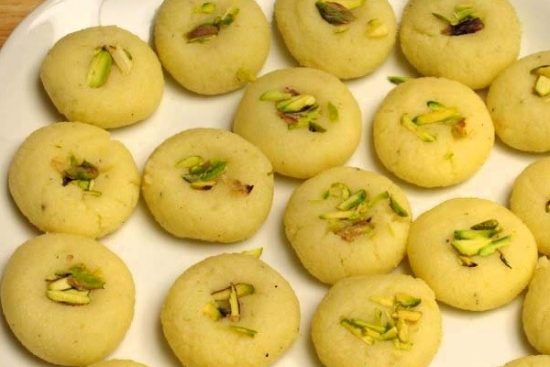Mama’s Punjabi Recipes- Coconut de Pede (CONDENSED MILK COCONUT DISKS)

It is that time of year when Fall colors and festivals – Diwali, Hanukah, Thanksgiving, Christmas – fill up all our days. There are parties big and small everywhere and lots of little things to snack on and this dish is a perfect fit and so easy to make. Below is a reprint of Mama’s Coconut de Pede recipe, which is a perfect little finger dessert for Diwali. It is reprinted with some additional information and directions.
There is no shortage of sweet confections in India as they are made of various types of base ingredients. Very few are actually made of flour dough and many use milk, either condensed, coagulated, reduced or separated for its whey and cheese. Most of these “sweetmeats” (as Indian are fond of calling them) are very rich in sugar calories and deep frying and adding nuts make them even more fattening. All the same, they are extremely delicious and hard to pass up.
Some sweets – like laddus (balls made of various ingredients), burfi (reduced milk squares), boondi (sweet fried gram flour drops) and pede (dough disks), apart from being eaten as a dessert, are often used as offerings to the deities in temples and then distributed to others as prasad (blessed food). But not all sweets are used in temples as offerings. They are often sold at the stalls and shops that line the way to the temple.
Pede is a sweet that is made with khoya (reduced milk), sugar and traditional flavorings like illachi (cardamom), piste (pistachio) and kesar (saffron) and can come in creamy white to a caramel color. Pede originated in the holy city of Mathura (associated with Lord Krishna) and these – along with petha (caramelized white pumpkin or winter melon) – is what the city is also famous for all over the country.
The traditional way halwais (confectioners) make pede is to first boil whole milk on a stove till it has evaporated down to a thick paste. They then make small disks of them. It’s a time consuming process that requires patience, a lot of supervision to stir the milk so that it doesn’t stick to the bottom and burn, and the ability to stand over a hot stove for long hours.
But there is a much simpler way too. This recipe allows the average home cook to cut back the work and still make tasty pede that can match the store made ones. It is quick and easy to make – in about 30 minutes – and those who eat it will never know the difference
Ingredients:
• 1 cup non-fat milk powder
• 1 cup bariq narrial powder (fine coconut powder)
• 7 oz (200 gm) condensed milk
• Condiments to taste: crushed piste (pistachioes); illachi (cardamom) powder
Directions:
1. Pour all the non-fat milk powder and coconut powder in a bowl and mix together.
2. Pour in the condensed milk and mix thoroughly.
3. Coat your hands with some vegetable oil so that the ball will not stick. Now knead the mixture till it forms into a ball.
4. Coat a clean dinner plate with a thin film of vegetable oil so that the pedde will not stick.
5. Take a small amount of dough and roll between your palms of till it forms into a small ball.
6. Place the ball on a serving plate and then press down with your palm to form a half-inch thick disk, about 1.25 inches in diameter.
7. Continue to make more disks with the remaining mixture.
8. To the top of each disk, place some crushed piste. Then sprinkle the entire plate lightly with the illachi powder.
9. Cover with some wrapping paper and place the plate in the fridge for an hour.
MAMA’S TIP OF THE WEEK: TO ADD SOME COLOR TO BURFI AND PEDE, USE SOME TURMERIC
Most people think of haldi (turmeric) as just another spice to cook with that gives off a deep yellow color. Some may even know that haldi is an effective antiseptic and skin lightener, both scientifically proven facts. But most people do realize that haldi stains on clothing is fairly difficult to get out if left untouched for awhile.
But what many people may not understand is that haldi is also often used as a coloring agent to make different foods, especially sweets like burfi and pede. If no other color is available, or if you want a slightly creamy color, just add a little haldi while kneading the dough and it will give a nice, pleasing color without adding any taste to the sweets.

Shakuntla Malhotra is a skilled cook of Punjabi dishes made in the old-fashioned style that she learnt as a young woman in her ancestral home in Lyallpur, India (since renamed Faisalabad) before it became part of Pakistan after the Partition in 1947. People have often admired her cooking for its simplicity and taste that comes with each mouthful. Even in her late-eighties, she continues to cook daily and agreed to share her delectable Punjabi recipes for future generations.
